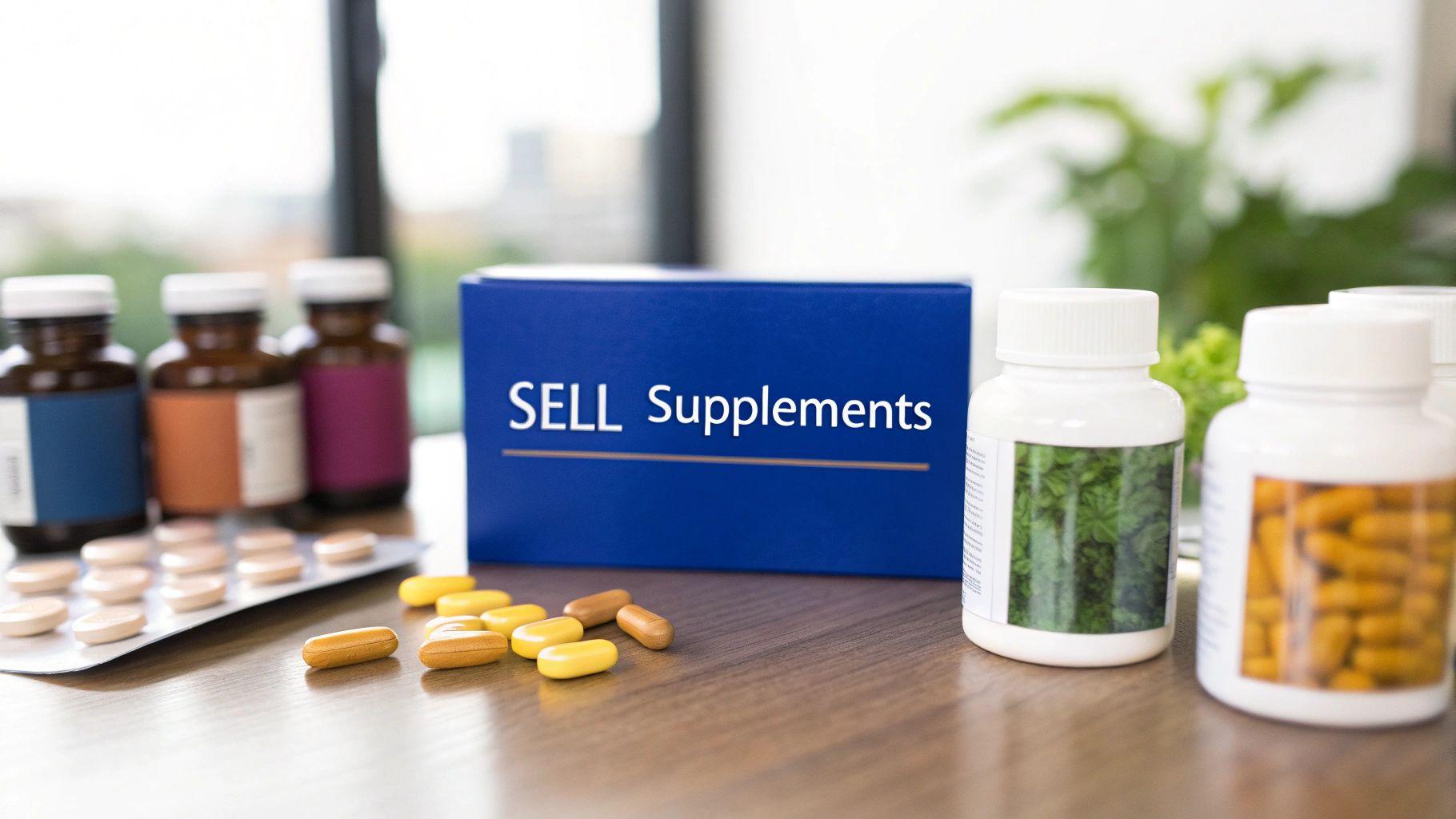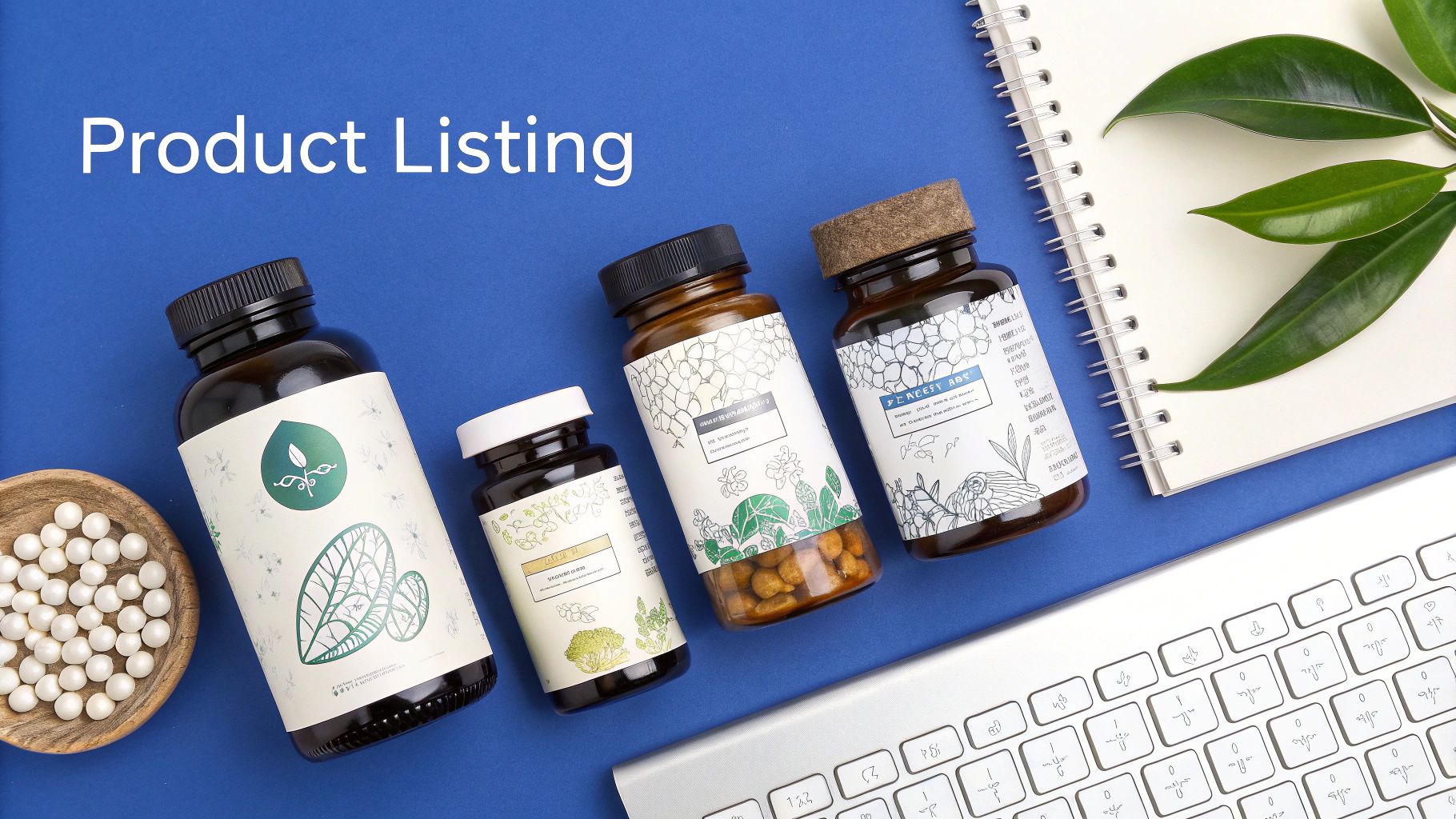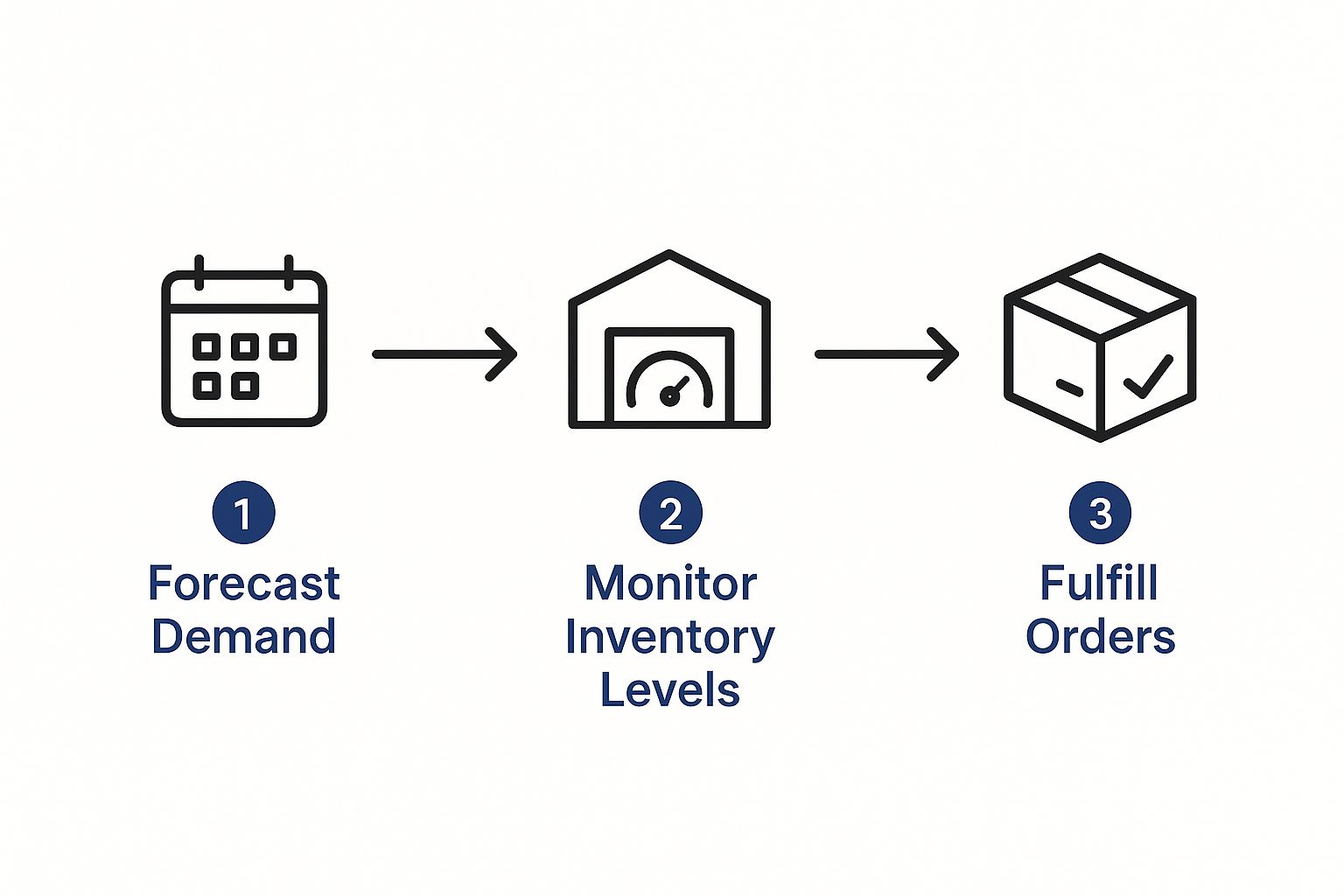How to Sell Supplements on Amazon | Complete Guide to Success
Learn how to sell supplements on Amazon with expert tips on compliance, sourcing, and marketing. Start building your profitable supplement brand today!
 Get a Free Quote Today!
Get a Free Quote Today!Let's be blunt: selling supplements on Amazon is a massive opportunity, but it’s not some get-rich-quick scheme. The potential is absolutely enormous, driven by a tidal wave of consumers who are making health and wellness a top priority. This isn't just a fleeting trend; it's a fundamental shift in how people shop, and Amazon is ground zero for this revolution.
To succeed, you'll need to navigate a maze of strict compliance rules, build a private-label brand that people actually trust, and craft a product listing that converts browsers into buyers. It all starts with getting the right documentation, like a Certificate of Analysis (CoA), mastering Amazon's approval process for the category, and then investing in top-notch branding and marketing to make sure you don't just blend in.
Why Selling Supplements on Amazon Is Worth the Effort

The sheer scale of the supplement market on Amazon is hard to overstate. The platform isn't just a player; it's the undisputed leader in the vitamin, minerals, and supplements (VMS) space, blowing past major retail chains.
The numbers speak for themselves. The supplement category is not just large; it's actively growing, presenting a clear opportunity for new brands to enter and find their footing.
Amazon Supplement Market at a Glance
The table below gives you a snapshot of just how significant this market has become on Amazon.
| Metric | Figure | Growth (Year-over-Year) |
|---|---|---|
| Annual VMS Sales | $12.6 Billion | +14.6% |
| Units Sold | 472 Million | N/A |
| Market Leader | Amazon | Far surpasses retail chains |
(Data from the 12 months leading up to August 2023)
These figures aren't just abstract numbers; they represent millions of customers actively searching for products to improve their health. The 14.6% year-over-year growth shows that this demand isn't slowing down. Your job is to position your brand to meet it.
Finding Your Place in a Crowded Market
Success on Amazon means understanding both the huge potential and the very real obstacles. The market is fueled by specific consumer needs you can tap into. For example, products that support immunity, cognitive function, and stress management are seeing a huge surge in demand. Your first real strategic move is to pinpoint a sub-niche within one of these larger categories.
For most sellers jumping into this space, private labeling is the smartest way to go. It’s your ticket to:
- Building a brand identity that’s entirely your own.
- Having total control over your product’s formula and quality.
- Setting your own prices without fighting other sellers on the same listing.
- Creating a tangible asset—a brand—that you could one day sell.
The real game isn't just selling a product; it's building a brand that customers see and trust. Amazon's strict rules, while a pain to deal with initially, actually become a protective moat around your business once you're on the inside. Compliance is what builds credibility here.
Turn the Hurdles into Your Advantage
The biggest barriers—the intense competition and Amazon's stringent regulations—are exactly what scare most people away. But you should see them differently. Think of them as your competitive edge.
Every rule you follow and every quality standard you meet is another hurdle that less serious, fly-by-night competitors won't bother to clear. Specialized niches, like CBD for pets, show just how much room there is for growth if you're willing to do the work. You can even find inspiration from existing success stories in promoting CBD for pets products.
This guide is designed to give you a realistic, no-fluff look at what it really takes. If you focus on creating a superior product, mastering the compliance game, and marketing with precision, you can carve out a profitable corner in this booming industry. This isn't about launching a single product; it's about building a real, sustainable business.
Building Your Brand Before You Launch
 A successful supplement brand isn't born the day you make your first sale. It's built, piece by piece, long before your product ever sees an Amazon warehouse. This is the foundational work—the part where you move from a vague idea to a strategic, market-ready business. Getting these early decisions right is what creates a brand that not only stands out but is built to last.
A successful supplement brand isn't born the day you make your first sale. It's built, piece by piece, long before your product ever sees an Amazon warehouse. This is the foundational work—the part where you move from a vague idea to a strategic, market-ready business. Getting these early decisions right is what creates a brand that not only stands out but is built to last.
The first mistake many new sellers make is thinking too broadly. Deciding to sell "protein powder" or "multivitamins" is a surefire way to get lost in a sea of identical competitors. The real opportunity is in the details, in finding a specific and profitable niche. Think deeper. Instead of "collagen," what about "vegan collagen builders for active women over 40?" That level of focus lets you speak directly to a clear audience with a problem you're uniquely positioned to solve.
Finding Your Profitable Niche
Identifying a great niche isn't about guesswork; it's a mix of smart market analysis and understanding what customers are genuinely struggling with. Start by digging into sub-niches within big, popular categories like sports nutrition, cognitive health, or immunity.
Look for the gaps. Are there specific dietary needs going unmet? For instance, a "keto-friendly liquid sleep aid" immediately targets a distinct lifestyle group with a very common problem. This targeted approach makes your marketing infinitely more effective and helps you build a loyal following from day one.
Vetting Your Manufacturing Partner
Once you've got your niche, the next make-or-break decision is choosing a manufacturing partner. This choice directly impacts your product quality, compliance, and ultimately, your brand's reputation. Don't cut corners here.
Your manufacturer must be cGMP-certified (Current Good Manufacturing Practices). This isn't just a nice-to-have; it's a non-negotiable standard for quality and safety.
When you're talking to potential partners, ask the tough questions to avoid headaches down the road:
- What's your experience with liquid supplements for Amazon FBA? They need to know Amazon's specific prep and labeling rules inside and out.
- Can you provide a Certificate of Analysis (CoA) for every single batch? This is your proof of the product's potency and purity.
- What are your minimum order quantities (MOQs)? A lower MOQ means less upfront financial risk while you're getting started.
- Do you help with formulation? A great partner can help you turn your concept into a stable, effective, and great-tasting product.
Working with an expert in private label liquid supplements can make this whole process smoother, guiding you from the initial idea all the way to fulfillment.
Formulating a Unique Product
Your product's formula is its unique selling proposition (USP). This is your chance to create something genuinely better than what's already out there. Maybe you create a "super stack" that combines several ingredients for a powerful synergistic effect, like a brain-booster with L-Theanine, Lion's Mane, and Bacopa Monnieri.
Even the delivery method can be a point of difference. While gummies are huge, don't overlook capsules. They still command about 30% of Amazon's supplement sales. Many consumers prefer capsules for their precise dosing, lack of sugar, and potential for higher potency, especially for benefits like energy and immunity. A brand that uses cGMP manufacturing to deliver a highly bioavailable capsule can carve out a serious market share.
The goal is simple: solve a specific problem in a unique way. Whether it’s through a more bioavailable ingredient, a novel combination, or just a better delivery system, your formulation is what will keep customers coming back.
Designing Compliant and Professional Packaging
Your packaging is the very first physical experience a customer has with your brand. It has to look professional, build immediate trust, and—most importantly—be 100% compliant with FDA and Amazon labeling rules. One tiny mistake on your label can get your entire listing suppressed.
Your label absolutely must display:
- The product name and your brand
- A complete Supplement Facts panel
- A full list of every ingredient
- The net quantity of the contents
- The name and address of the distributor or manufacturer
Seriously, invest in a professional designer who understands the ins and outs of supplement regulations. Your packaging needs to do more than just meet legal requirements; it has to visually communicate your brand's quality and connect with your target customer. This is the strategic groundwork you need to lay before you can even think about how to sell your supplements on Amazon. It’s the foundation for everything that comes next.
Mastering Amazon's Strict Compliance Requirements
Trying to launch a supplement brand on Amazon without a deep respect for its rules is a recipe for disaster. I've seen it happen time and time again. This isn't just bureaucratic red tape; it's the very foundation of customer trust on the platform.
For many new sellers, navigating Amazon's compliance maze feels like the hardest part of the entire journey. But here's a secret from someone who's been in the trenches: mastering it is your single greatest competitive advantage. It’s what separates the flash-in-the-pan sellers from the brands that stick around for the long haul.
It's so easy to get caught up in the excitement of product formulas and marketing that compliance becomes an afterthought. This is a fatal mistake. You have to be proactive. That means understanding the rules so well that you build your entire operation—from sourcing to labeling—to sidestep problems before they even have a chance to pop up. This approach is what will shield you from listing removals, account suspensions, and the devastating loss of customer trust that follows.
The Non-Negotiable Documentation Checklist
To even think about selling supplements, you need a fortress of documentation. Amazon demands this to prove your product is safe, accurately labeled, and made in a high-quality facility. Let me be clear: trying to get by without these documents isn't a strategy. It's just a matter of when, not if, Amazon will come knocking. And when they do, you better be ready.
There are two core documents that are the absolute bedrock of your compliance file:
- Certificate of Analysis (CoA): This is your scientific proof of what’s actually in your product, issued by an ISO/IEC 17025 accredited lab. It verifies that the ingredients and their potencies match your label and confirms the product is free from nasty contaminants. You'll need a new CoA for every single batch you produce.
- Proof of cGMP Registration: You must have evidence that your manufacturer follows the FDA's Current Good Manufacturing Practices (21 CFR 111). This is your guarantee of quality control throughout the entire manufacturing process.
Pro Tip: Never, ever accept a CoA from your manufacturer and just forward it to Amazon. Amazon's policy often requires the testing lab to send the results directly. This is their way of ensuring the analysis is legitimate and hasn't been tampered with.
To help you prioritize, it’s useful to understand what Amazon considers mandatory versus what’s simply a good idea to have on hand.
Required vs Recommended Documentation for Amazon
This table breaks down the essentials, helping you focus your compliance efforts where they matter most for getting your supplement listed and keeping it live.
| Document Type | Requirement Level | Purpose and Key Details |
|---|---|---|
| Certificate of Analysis (CoA) | Required | Issued by an ISO/IEC 17025 lab for each batch. Verifies ingredient identity, potency, and purity. Amazon often requires this to be submitted directly from the lab. |
| Proof of cGMP Compliance | Required | A certificate showing your manufacturer adheres to FDA cGMP standards (21 CFR Part 111). This is non-negotiable proof of quality manufacturing. |
| Product Invoices | Required for Ungating | Must be from your manufacturer/supplier, dated within 180 days, show a purchase of 10+ units, and have business details matching your Seller Central account. |
| Letter of Guarantee (LoG) | Recommended | A statement from your manufacturer confirming the product is safe and compliant. While not always required upfront, it’s powerful supporting evidence if issues arise. |
| Product Liability Insurance | Recommended (Required over $10k/mo) | Not needed for ungating, but Amazon's policies require it once you hit $10,000 in gross sales for 3 consecutive months. It's smart to have from day one. |
Having these documents organized and ready to go isn't just about passing an initial check; it's about building a resilient business that can withstand scrutiny down the road.
Getting Through the Category Ungating Process
The Dietary Supplements category on Amazon is "gated." This means you need to get explicit permission to sell in it. This process, which we call "ungating," is where all your meticulous prep work pays off. Amazon's whole goal here is to filter out sellers who can't meet their high standards for safety and quality.
To get the gate open, you'll generally need to submit:
- Valid Invoices: An invoice from your manufacturer dated within the last 180 days. It needs to show a real purchase (think 10+ units) and include your business name and address, which must match your Seller Central info exactly.
- Product Images: You'll need crystal-clear, high-resolution photos of your product and its packaging. The images must make it easy to read the supplement facts panel, the full ingredient list, and your brand's name and address.
- Required Certifications: This is where you hand over your proof of cGMP registration and have that CoA ready to go when they ask for it.
Once you're live, managing your inventory becomes a key part of staying compliant and keeping your seller account in good health.

This workflow isn't just about logistics; it’s about making sure you never run out of stock. Going out of stock can kill your sales velocity and tank your Best Seller Rank (BSR), which is incredibly hard to recover from.
Staying Compliant and Avoiding Pitfalls
Getting approved is just the start. Staying compliant is an ongoing battle. Amazon is always watching, especially for listings making sketchy health claims.
The absolute fastest way to get your listing yanked or your whole account suspended is to make a prohibited medical claim. That means saying your product can diagnose, treat, cure, or prevent any disease. Don't do it. Period.
This is also where a great manufacturing partner becomes invaluable. A truly experienced partner won't just follow cGMP standards; they’ll be your guide through the documentation maze. For brands that need that level of support, exploring a top-tier nutraceutical contract manufacturing service can provide the deep compliance expertise you need to navigate these waters with confidence.
When you stop seeing compliance as a hurdle and start treating it as a core business function, you build a brand that can weather any storm. You create unshakable trust with both Amazon and your customers—and that's the real foundation for long-term success.
Crafting an Amazon Listing That Actually Sells

Think of your Amazon listing as your best salesperson, working tirelessly around the clock. In the cutthroat world of supplements, a lazy, uninspired listing is a death sentence for your product. To turn scrollers into buyers, you need to treat your product detail page like a masterclass in persuasion. It has to solve problems, build immediate trust, and shout your brand's value from the rooftops.
This whole process kicks off long before you type a single word of copy. It all starts with digging deep into keyword research, specifically for the supplement niche. Your mission is to uncover the exact search terms your ideal customers are using when they’re looking for the very solution you're offering.
Go beyond the obvious, generic stuff like "liquid vitamin C." You need to hunt for the long-tail keywords that reveal what the customer truly wants. Think phrases like "immune support liquid vitamin for kids" or "high absorption vitamin C drops." These specific terms not only face less competition but also attract shoppers who are already halfway to the 'buy now' button.
Write Copy That Speaks to Your Customer's Needs
With your keyword list in hand, it's time to weave those phrases into copy that connects on a human level. Here's a hard truth: shoppers don't buy ingredients; they buy solutions. Your title, bullets, and description need to scream benefits, not just list features.
A feature is what your product is (e.g., "Contains 1000mg of Ashwagandha"). A benefit is what your product does for them (e.g., "Helps you feel calm and collected on those overwhelmingly stressful days").
Let's look at an example:
- Weak Title (Feature-Focused): "Herbal Supplement with Ashwagandha Root"
- Strong Title (Benefit-Focused): "ZenCalm Liquid Ashwagandha Drops for Stress Relief and Mood Support - Natural Adaptogen for Relaxation"
See the difference? The second one sells a feeling, a solution. Apply this same thinking to your bullet points. Each one is a mini-sales pitch—a chance to solve a problem, build more trust, and hammer home a key benefit. Of course, writing great copy is only half the battle; for a deeper look into the technical side, it's worth reading up on mastering Amazon SEO and improving product rankings.
Go Beyond the Bullets with A+ Content
A+ Content is where you get to truly bring your brand's story to life. This is your canvas to use high-quality graphics, insightful comparison charts, and powerful lifestyle images to build a much deeper connection with shoppers.
Use your A+ Content to:
- Show Off Your Quality: Visually break down your formula. If you use a premium ingredient, show where it comes from. For example, helping customers understand the different herbal extraction methods can powerfully communicate why your liquid formula is superior.
- Tell Your Brand's Story: Who are you? What’s your mission? This is your chance to forge an emotional bond that a simple transaction can't create.
- Handle Objections Before They Happen: Use charts to stack your product up against competitors or visually answer common questions, proving why your supplement is the smartest choice.
A+ Content has been shown to boost conversion rates by up to 10%. It's not a "nice-to-have" extra; it's an essential tool for building the credibility and trust you need to succeed in the Amazon supplement space.
The Decisive Power of Visuals
Never, ever skimp on professional photography and videography. Customers can't touch, smell, or taste your supplement before buying, so your visuals have to do all the heavy lifting. Your main image must be sharp, clean, and perfectly compliant with Amazon's rules. But your secondary images? That's where you can really tell a story.
Invest in lifestyle shots that show your product in its element. Help customers picture themselves reaping the benefits. Selling a pre-workout? Show a focused, energetic person crushing their gym session. Selling a sleep aid? Use a serene, peaceful bedroom setting. These images make the benefits tangible and build the trust needed to get shoppers to click "Add to Cart" in this incredibly crowded market.
Executing a Powerful Launch and Marketing Plan
Having a top-notch product and a perfectly tuned listing gets you in the game, but it doesn't guarantee a win. To really succeed with supplements on Amazon, you absolutely need momentum from day one. This means rolling out a modern, multi-channel marketing plan built to drive immediate sales and create a flywheel for long-term growth.
Think of your launch not as a single event, but as a carefully orchestrated campaign. The goal? To scream at Amazon's algorithm that your product is hot, relevant, and in-demand. We need to drive sales, lock in those first crucial reviews, and watch that Best Seller Rank (BSR) start to climb. A strong launch makes everything else—from organic ranking to repeat customers—so much easier down the road.
Structuring Your Amazon PPC Campaigns
Amazon Pay-Per-Click (PPC) is going to be the main engine for your initial traffic. But please, don't just "set it and forget it." That's a surefire way to burn through your cash with little to show for it. For supplements, a structured, phased approach is non-negotiable for controlling costs and hitting the right shoppers.
I always start with a specific mix of campaigns:
- Automatic Campaigns: First, let Amazon do some of the heavy lifting. Run an auto campaign for a week or two. Its job is to sniff out new, relevant keywords for you. Once it's run its course, you'll dive into the search term report and harvest all the profitable terms that actually led to sales.
- Manual Campaigns (Broad & Phrase Match): Take those winning keywords you just discovered and plug them into broad and phrase match campaigns. This is how you capture a wider net of shoppers who are actively looking for solutions your product provides.
- Manual Campaigns (Exact Match): This is your sniper rifle. Target your most valuable, highest-converting keywords here. Once you have solid performance data, this is where you can get more aggressive with your bids to own that top spot.
This tiered strategy lets you discover what works without just throwing money at the wall, then allows you to double down on the search terms that are actually ringing the register.
Using Promotions to Spark Initial Sales
Early on, you've got to give shoppers a little nudge to get the ball rolling. Amazon’s promotional tools are brilliant for this. They create a sense of urgency and value that can easily push a hesitant buyer over the finish line.
Key Insight: The first few weeks of your product's life are make-or-break. Amazon's A9 algorithm puts a massive weight on initial sales velocity when deciding where to rank you. A powerful start can set you up for long-term organic visibility that you won't have to pay for later.
Here are a couple of promotions to get going with immediately:
- Coupons: This is the easiest and one of the most effective ways to stand out in a crowded search result page. That little eye-catching orange badge can seriously boost your click-through rate.
- Virtual Bundles: Got other products that pair well with your new supplement? Create virtual bundles. This is a fantastic way to increase your average order value and introduce customers to more of your catalog. For instance, you could bundle your new liquid sleep aid with an existing magnesium supplement.
These promotions aren't just about the immediate sale; they're about spinning up the Amazon flywheel. More sales lead to a better BSR, which leads to more organic visibility, which—you guessed it—leads to even more sales.
Driving High-Quality External Traffic
While Amazon PPC is your workhorse, you can give your BSR a serious jolt by sending targeted external traffic to your listing. Funneling visitors from platforms like Instagram, TikTok, or a niche health blog sends a powerful signal to Amazon that your product has buzz beyond its own walls.
The Amazon marketplace is a behemoth, with independent sellers making up about 60% of its sales volume. The supplement category is a huge beneficiary of this traffic, especially since 90% of Prime members are there for the convenience and free shipping. By driving your own traffic, you're tapping into this ready-to-buy audience while telling Amazon your product deserves attention.
But don't just think in terms of paid ads. Get creative with modern tactics like leveraging user-generated video content to build real trust and social proof. An authentic video review from a real customer can be infinitely more persuasive than the most polished ad copy you could ever write. This approach doesn't just drive traffic; it builds a genuine community around your brand—and that's the key to thriving long after your launch is over.
Got questions about selling supplements on Amazon? You’re not alone. When you’re diving into a category this complex, the practical, nitty-gritty details are what trip most people up.
Let's cut through the noise. I’ve rounded up the most common questions I hear from new sellers and laid out clear, no-fluff answers to help you move forward with confidence.
Do I Really Need an LLC to Sell Supplements on Amazon?
You technically don't, but starting as a sole proprietor is playing with fire. My strong advice? Form a Limited Liability Company (LLC) from day one. The main reason is simple: asset protection.
An LLC creates a legal wall between your business and your personal life. Supplements are a high-risk category. If a customer has an adverse reaction and decides to sue, your LLC can protect your personal assets—your house, your car, your savings—from being on the line. Beyond that, it signals a level of seriousness that top-tier manufacturers and insurance providers look for. Many won’t even talk to you without it.
What’s a Realistic Startup Budget?
Budgeting is where dreams meet reality. If you're launching a private label supplement, you need to be prepared for an initial investment somewhere between $5,000 and $15,000+. Trying to do it on the cheap by cutting corners on quality or compliance is a guaranteed recipe for failure.
Here’s a realistic look at where that money goes:
- Product & Inventory: This is your biggest ticket item, easily running $3,000 to $10,000. It all depends on your manufacturer's minimum order quantity (MOQ).
- Compliance & Testing: Don't skip this. Budget $500 to $2,000 for crucial documents like a Certificate of Analysis (CoA) from a legitimate, third-party lab.
- Branding & Photography: Your product has to look professional. Plan for $500 to $2,500 for killer packaging design and high-quality product photos. First impressions are everything.
- Launch Advertising: You have to spend money to make money. Set aside at least $1,000 to $3,000 for your initial Pay-Per-Click (PPC) campaigns to get the ball rolling.
A huge mistake I see people make is underestimating their ad budget. Your launch ads are what feed Amazon's algorithm the initial sales velocity it needs to see your product as relevant. Without it, you're dead in the water.
What Are the Fastest Ways to Get Banned?
Getting suspended in the supplement category almost always boils down to one thing: compliance failures. Amazon is absolutely ruthless about protecting its customers, and they don't give second chances.
If you want a fast track to getting your account shut down, try one of these:
- Making Disease Claims: This is the cardinal sin. You cannot say your product treats, cures, prevents, or mitigates any disease. Period.
- Using Fake or Invalid Documents: When Amazon asks for a valid CoA or proof of cGMP manufacturing, you better have it. Forging documents or using an unaccredited lab is a quick way to get banned for life.
- Selling Banned Ingredients: Amazon has a long and constantly updated list of prohibited ingredients. It's your job to know what's on it.
- Manipulating Reviews: Don't even think about it. Buying reviews, incentivizing positive feedback—any attempt to game the system is a major policy violation that Amazon's tech is getting better and better at catching.
Should I Use FBA or FBM for Supplements?
For 99% of supplement sellers, Fulfillment by Amazon (FBA) is the only logical choice. The decision comes down to two letters: P-R-I-M-E.
The Prime badge is a massive driver of conversions. Supplement buyers expect fast, free shipping, and they trust the Prime promise. Without it, you’re at a huge disadvantage.
Sure, you could fulfill orders yourself with Fulfillment by Merchant (FBM), but then you’re on the hook for climate-controlled storage (a must for many supplements) and hitting Amazon’s insane shipping performance metrics. For most sellers, the benefits of FBA—Prime eligibility, outsourced logistics, and Amazon handling customer service—are well worth the fees. It’s the clear winner here.